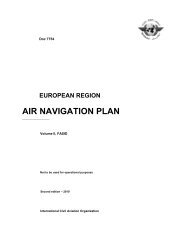7754 Vol 1 Flyleaf - ICAO Public Maps
7754 Vol 1 Flyleaf - ICAO Public Maps
7754 Vol 1 Flyleaf - ICAO Public Maps
You also want an ePaper? Increase the reach of your titles
YUMPU automatically turns print PDFs into web optimized ePapers that Google loves.
Part VII<br />
SEARCH AND RESCUE (SAR) SERVICES<br />
PROVISION OF SAR<br />
1. Planning for search and rescue services should be<br />
based to the maximum practicable extent on existing<br />
services and facilities even if these are not provided<br />
primarily for search and rescue purposes, in order to obtain<br />
a reasonable cost-effectiveness relationship in maintaining<br />
these services and facilities in the required state of<br />
readiness.<br />
[Annex 12, 3.2.1, SAR/M, 2.5, 3.2.1]<br />
2. In addition, arrangements should be made to<br />
permit a call on any national services likely to be able to<br />
render assistance on an ad hoc basis, in those cases when<br />
the scope of SAR operations requires such assistance.<br />
[SAR/M, 3.2.1]<br />
3. Plans should be drawn up to activate and<br />
coordinate all available emergency services, including<br />
medical care facilities, in the event of an aircraft accident<br />
involving a large number of survivors.<br />
COOPERATION BETWEEN<br />
SAR SERVICES<br />
4. States should conclude agreements regarding<br />
co-operation of their SAR services in border areas and,<br />
more especially, over the high seas and in inhospitable<br />
areas (deserts, mountainous areas) where speediest possible<br />
action is essential to the success of SAR operations.<br />
[Annex 12, 3.1, SAR/M, 3.1]<br />
5. Each State should designate a single SAR Point of<br />
Contact (SPOC) to facilitate cooperation with the<br />
associated mission control centre (MCC) of the<br />
COSPAS/SARSAT system in order to ensure the timely<br />
distribution of distress data.<br />
VII-1<br />
Note 1.— A SPOC may be an aeronautical or a<br />
maritime Rescue Co-ordination Centre (RCC).<br />
Note 2.— COSPAS = Space System for Search of<br />
Vessels in Distress; SARSAT = Search and Rescue<br />
Satellite-aided Tracking.<br />
SEARCH AND RESCUE FACILITIES<br />
6. Having regard to the increased size and passenger<br />
capacity of modern aircraft, States should ensure that the<br />
capabilities of their SAR facilities, including those that are<br />
part of inter-State agreements in maritime areas, are kept<br />
under constant review.<br />
[Annex 12, 2.6.1]<br />
7. SAR facilities should be so located that they can be<br />
activated with the least possible delay. In meeting this<br />
requirement the availability of search aircraft on a<br />
redeployment basis is acceptable.<br />
8. Minimum requirements should, whenever possible,<br />
be supplemented by any additional facilities.<br />
[Annex 12, 2.5]<br />
PROVISIONS FOR SPECIFIC<br />
FLIGHT OPERATIONS<br />
9. Where necessary, States should make appropriate<br />
arrangements, in cooperation with each other if required, to<br />
ensure that flight operations that, due to their nature,<br />
present particular problems in the field of SAR, are<br />
adequately covered (e.g. helicopter operations over the high<br />
seas).














